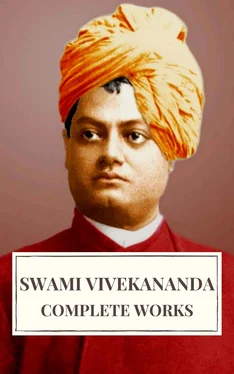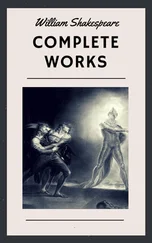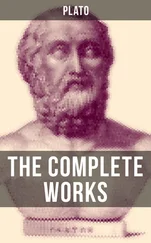The ideal of the Yogi, the whole science of Yoga, is directed to the end of teaching men how, by intensifying the power of assimilation, to shorten the time for reaching perfection, instead of slowly advancing from point to point and waiting until the whole human race has become perfect. All the great prophets, saints, and seers of the world — what did they do? In one span of life they lived the whole life of humanity, traversed the whole length of time that it takes ordinary humanity to come to perfection. In one life they perfect themselves; they have no thought for anything else, never live a moment for any other idea, and thus the way is shortened for them. This is what is meant by concentration, intensifying the power of assimilation, thus shortening the time. Raja-Yoga is the science which teaches us how to gain the power of concentration.
What has Pranayama to do with spiritualism? Spiritualism is also a manifestation of Pranayama. If it be true that the departed spirits exist, only we cannot see them, it is quite probable that there may be hundreds and millions of them about us we can neither see, feel, nor touch. We may be continually passing and repassing through their bodies, and they do not see or feel us. It is a circle within a circle, universe within universe. We have five senses, and we represent Prana in a certain state of vibration. All beings in the same state of vibration will see one another, but if there are beings who represent Prana in a higher state of vibration, they will not be seen. We may increase the intensity of a light until we cannot see it at all, but there may be beings with eyes so powerful that they can see such light. Again, if its vibrations are very low, we do not see a light, but there are animals that may see it, as cats and owls. Our range of vision is only one plane of the vibrations of this Prana. Take this atmosphere, for instance; it is piled up layer on layer, but the layers nearer to the earth are denser than those above, and as you go higher the atmosphere becomes finer and finer. Or take the case of the ocean; as you go deeper and deeper the pressure of the water increases, and animals which live at the bottom of the sea can never come up, or they will be broken into pieces.
Think of the universe as an ocean of ether, consisting of layer after layer of varying degrees of vibration under the action of Prana; away from the centre the vibrations are less, nearer to it they become quicker and quicker; one order of vibration makes one plane. Then suppose these ranges of vibrations are cut into planes, so many millions of miles one set of vibration, and then so many millions of miles another still higher set of vibration, and so on. It is, therefore, probable, that those who live on the plane of a certain state of vibration will have the power of recognising one another, but will not recognise those above them. Yet, just as by the telescope and the microscope we can increase the scope of our vision, similarly we can by Yoga bring ourselves to the state of vibration of another plane, and thus enable ourselves to see what is going on there. Suppose this room is full of beings whom we do not see. They represent Prana in a certain state of vibration while we represent another. Suppose they represent a quick one, and we the opposite. Prana is the material of which the: are composed, as well as we. All are parts of the same ocean of Prana, they differ only in their rate of vibration. If I can bring myself to the quick vibration, this plane will immediately change for me: I shall not see you any more; you vanish and they appear. Some of you, perhaps, know this to be true. All this bringing of the mind into a higher state of vibration is included in one word in Yoga — Samadhi. All these states of higher vibration, superconscious vibrations of the mind, are grouped in that one word, Samadhi, and the lower states of Samadhi give us visions of these beings. The highest grade of Samadhi is when we see the real thing, when we see the material out of which the whole of these grades of beings are composed, and that one lump of clay being known, we know all the clay in the universe.
Thus we see that Pranayama includes all that is true of spiritualism even. Similarly, you will find that wherever any sect or body of people is trying to search out anything occult and mystical, or hidden, what they are doing is really this Yoga, this attempt to control the Prana. You will find that wherever there is any extraordinary display of power, it is the manifestation of this Prana. Even the physical sciences can be included in Pranayama. What moves the steam engine? Prana, acting through the steam. What are all these phenomena of electricity and so forth but Prana? What is physical science? The science of Pranayama, by external means. Prana, manifesting itself as mental power, can only be controlled by mental means. That part of Pranayama which attempts to control the physical manifestations of the Prana by physical means is called physical science, and that part which tries to control the manifestations of the Prana as mental force by mental means is called Raja-Yoga.
Chapter IV. The Psychic Prana
According to the Yogis, there are two nerve currents in the spinal column, called Pingalâ and Idâ, and a hollow canal called Sushumnâ running through the spinal cord. At the lower end of the hollow canal is what the Yogis call the “Lotus of the Kundalini”. They describe it as triangular in form in which, in the symbolical language of the Yogis, there is a power called the Kundalini, coiled up. When that Kundalini awakes, it tries to force a passage through this hollow canal, and as it rises step by step, as it were, layer after layer of the mind becomes open and all the different visions and wonderful powers come to the Yogi. When it reaches the brain, the Yogi is perfectly detached from the body and mind; the soul finds itself free. We know that the spinal cord is composed in a peculiar manner. If we take the figure eight horizontally (∞) there are two parts which are connected in the middle. Suppose you add eight after eight, piled one on top of the other, that will represent the spinal cord. The left is the Ida, the right Pingala, and that hollow canal which runs through the centre of the spinal cord is the Sushumna. Where the spinal cord ends in some of the lumbar vertebrae, a fine fibre issues downwards, and the canal runs up even within that fibre, only much finer. The canal is closed at the lower end, which is situated near what is called the sacral plexus, which, according to modern physiology, is triangular in form. The different plexuses that have their centres in the spinal canal can very well stand for the different “lotuses” of the Yogi.
The Yogi conceives of several centres, beginning with the Mulâdhâra, the basic, and ending with the Sahasrâra, the thousand-petalled Lotus in the brain. So, if we take these different plexuses as representing these lotuses, the idea of the Yogi can be understood very easily in the language of modern physiology. We know there are two sorts of actions in these nerve currents, one afferent, the other efferent; one sensory and the other motor; one centripetal, and the other centrifugal. One carries the sensations to the brain, and the other from the brain to the outer body. These vibrations are all connected with the brain in the long run. Several other facts we have to remember, in order to clear the way for the explanation which is to come. This spinal cord, at the brain, ends in a sort of bulb, in the medulla, which is not attached to the brain, but floats in a fluid in the brain, so that if there be a blow on the head the force of that blow will be dissipated in the fluid, and will not hurt the bulb. This is an important fact to remember. Secondly, we have also to know that, of all the centres, we have particularly to remember three, the Muladhara (the basic), the Sahasrara (the thousand-petalled lotus of the brain) and the Manipura (the lotus of the navel).
Читать дальше












